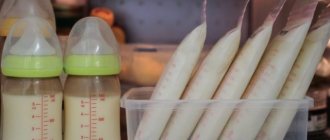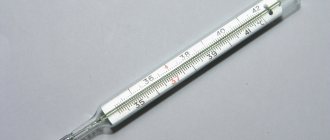Expressed milk is usually fed in cases where the mother needs to go somewhere or in other “force majeure” situations. In such cases, you need to prepare a milk “bank” and know how to warm up expressed breast milk. In this case, you will have to study not only in theory, but also in practice such issues as pumping itself, storing and feeding milk in a bottle. The health and well-being of the baby depends on this.
How to pump
There are two options for expressing: using your hands and using a breast pump. Both methods have their advantages and disadvantages. Each woman chooses what is most convenient for her. If you have to pump constantly, then you should buy a good ergonomic breast pump. In this case, preference is given to electric ones, but a mechanical piston device also has good characteristics.
The mammary glands empty as often as the mother needs. If bottle feeding occurs regularly, then express every time after feeding. The baby is given one breast, and the second must be expressed and the container put in the refrigerator. When the baby is completely bottle-fed, it is best to choose a breast pump for both breasts and express according to the feeding regimen.
If during the newborn period the baby is fed every 1.5-2 hours, then it should be expressed at the same frequency. The older the child gets, the longer the intervals between pumping.
How to calculate the required amount of milk?
If a baby suckles, he receives as much milk as he needs to be full.
In the case of bottle feeding, a woman needs to be able to calculate the volume of liquid the baby needs. This is important so that the child does not remain hungry. The amount of milk required depends on the age and weight of the baby. You can calculate the volume of a single serving using a special formula. The baby’s body weight in grams must be divided by 6. The resulting number is the daily volume of breast milk necessary for the normal development and growth of the baby.
It should be divided by the number of feedings per day. On average, babies eat 5-8 times. For example, a child's weight is 3600 grams. A baby needs 600 ml of mother's milk per day (3600:6=600). The baby eats 7 times a day. He needs to be given about 85 ml of food at a time. This calculation method cannot be called 100% accurate. We must understand that each child’s body is individual.
Some children have faster metabolic processes, so they need more food. Premature babies need increased nutrition. Gender also has a certain influence. For example, boys weighing 5-6 kg drink approximately 830 ml of breast milk per day, and girls - 775 ml.
The daily amount of milk for children with different body weights in the table:
| Child's weight in grams | Daily volume of mother's milk |
| 2500 | 390 |
| 3000 | 470 |
| 3500 | 550 |
| 4000 | 625 |
| 4500 | 705 |
| 5000 | 780 |
| 5500 | 860 |
| 6000 | 940 |
The approximate amount of milk per day and per feeding for children of different ages is in the table:
| Baby's age | Daily milk volume in ml | Size of a single serving, ml |
| 1-4 days | 350 | 60 |
| 4-7 days | 450 | 80 |
| 7-14 days | 20% of body weight | 90 |
| From two weeks to a month | 600 | 120 |
| 1-2 months | 800 | 150 |
| 3-4 months | 18% by weight | 200 |
| Up to six months | 1000 | 220 |
| Up to a year | 12% of body weight | 250 |
What to pump into
If expressing with your hands, you can use a bowl or a large deep plate. Before the process, you should wash it thoroughly and sterilize it.
If a breast pump is used, it comes immediately with a bottle with the nipple removed. But there are other types, they are not so convenient because the milk comes into a small tank, which must be emptied periodically.
Each expressed portion is stored separately. There is no need to add newly expressed milk to a container with existing milk. This will worsen its safety.
How to express properly?
Before the procedure, you need to wash your hands and prepare a container for collecting milk. Place your thumb and index finger on the edge of the areola. Apply light pressure to your chest. Squeeze and move your fingers in the direction from the areola to the nipple. For better milk release, you must first perform a massage and drink warm drinks.
Manual milk expression technique
What to store in
You can store it in the bottles you used to express it. But this is only if you have a sufficient supply or the milk is used almost immediately. You can also pour it into glass jars, for example, from baby purees or juices. But before that, you need to sterilize the containers and dry them thoroughly. They are only suitable for storage in the refrigerator. For the freezer, it is better to use disposable bags. They are more practical, airtight and sterile.
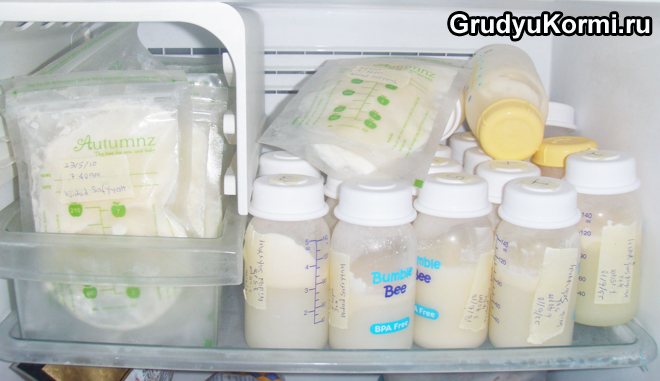
Each container must be dated and timed. This will allow you to use milk on time and not give your baby expired milk. This is also done in order to understand at what time it separates more.
You can store at room temperature for 6 hours if it does not exceed 28 degrees. If the apartment is cool, up to 22 degrees, then you can store it for 8-10 hours. In the refrigerator, the shelf life can last from 4 to 8 days. The longest period is in the freezer. There it can lie for up to 3 months, and in the extra-frozen compartment - 6-12 months.
How to give your baby expressed milk
One to two weeks before the “X-hour”, begin to introduce your baby to the bottle and pacifier. The most important thing is to choose the “right” nipple on the bottle: it is better that it has a small hole, which will prevent the baby from getting accustomed to sucking too lightly, after which he may simply refuse to take the breast. If your baby refuses to eat from a bottle, try offering him a different pacifier first (for example, replacing a round pacifier with an anatomical or orthodental one). Swap out a latex pacifier for a silicone one, or maybe your child will like the opposite. If the baby is already familiar with the pacifier, then give him a pacifier that is similar in shape.
Try to ensure that by the time you go back to work, your baby is used to at least one bottle feeding a day, and it is better if he is fed by a person who will stay with him during his mother’s absence: dad, grandmother or nanny.
How to heat milk
If the milk was in the room, then there is no need to heat it. But if the room is quite cool, then you can warm it up a little. There are several types of heating, each of them is convenient in its own way. Of course, when frozen and then defrosted, a lot of useful substances are lost. But at the same time, the majority remains, and most importantly, mother’s milk is preserved, which is much better than artificial formula.
In running water
This method is the simplest and most convenient. It is available in almost any situation. For this, the container must be placed in a wider bowl and watered with hot water. The milk is heated. But it's worth making sure it doesn't get too hot.
The undoubted advantage in this case is the method’s low cost, simplicity, and accessibility. But it can take quite a long time to reheat this way, especially if it’s frozen.
In the microwave
This method is quite controversial. Many are against it because they believe that the waves emitted during microwave operation are harmful and negatively affect the quality and benefits of milk. But there are also those who see nothing wrong with this. It’s probably only a plus, since the milk heats up there the fastest.
In order to heat milk in the microwave, you just need to put the package or put the bottle inside and set the desired time. If it is frozen, then first it is better to set the defrost mode. Then, at maximum power, 30-60 seconds are enough for the milk to reach the required temperature.
Naturally
The safest, but also the longest-lasting, is the heating (defrosting) method at room temperature. Most lactation consultants and doctors consider it the best, since milk is not affected by elevated temperatures, that is, all the beneficial properties remain. But it can take 4-5 hours, which is not particularly convenient.
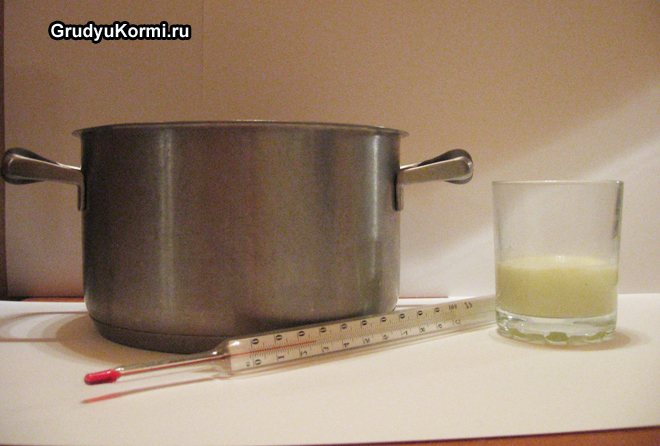
In the bottle warmer
This method is very convenient because you can put several bottles in a warmer and maintain the required temperature there. After it, you don’t need to do anything else, but just give the baby a bottle. If milk is frozen in bags, then you need to defrost it first using the methods suggested above. Next, pour it into a bottle and place it in the heater.
How to express milk correctly
So, you already understand that you cannot do without effective pumping. Doing this by hand is not very convenient: firstly, the process takes a lot of time, and secondly, there is a high probability of pathogenic microbes getting into the milk. For regular pumping, a breast pump is ideal, and you will have to master this “miracle of technology” to perfection.
- Drink a cup of hot tea or other drink before pumping. This promotes a freer flow of milk.
- Wash your hands and breasts, prepare a clean and dry breast pump.
- Massage your breasts and nipples to make pumping easier; Take a comfortable position.
- Place the breast pump funnel against your breast so that the nipple is approximately in the center. Please ensure that the parts of the device fit tightly to the skin and that the skin is dry, otherwise it will be difficult to create the necessary vacuum.
- Start squeezing the breast pump handle, or pressing the plunger, or simply turn the switch if the breast pump is electric. If you feel any discomfort, press the pressure release button (if your model has one) or simply place your fingertip between your skin and the breast pump breast shield. When the milk flows out quite strongly, there is no need to continue pumping the handle or piston and you can wait until the active flow ends; in the electric model, you can adjust the pumping force using a special regulator. There are models of electric breast pumps in which several movements can be made with your hands, achieving an effective and comfortable mode that the breast pump will “remember” and work in this rhythm.
- When the flow weakens significantly, repeat the breast massage and express the last portions.
- It is necessary to collect milk from both glands, with the exception of the last expression.
- Disconnect the bottle (package) from the breast pump, close the lid tightly and put it in the refrigerator. Disassemble the device, wash all its parts with water and detergent (preferably with baby dishwashing liquid).
Rules for storing expressed milk At room temperature 19-22 °C, fresh expressed milk can be stored for up to 10 hours, and at 25 °C for up to 4-6 hours. But it is better to store milk in the refrigerator. If the mother plans to feed the baby with freshly expressed milk no later than 3 hours later, then it does not need to be put in the refrigerator. The maximum possible storage time for expressed milk in the refrigerator (at a temperature of 0-4 ° C) is 7-8 days, in the freezer - up to 3-6 months. In special deep-frozen freezers (at a temperature of −19 °C), the shelf life of milk increases to 12 months. It is convenient to pour milk into special plastic (or glass) containers or bags, in small portions (from 30 to 120 ml), which can be heated or defrosted as needed. It is recommended to write the date of expressing milk on each container. If you pumped milk at work and plan to freeze it at home, then you should not first freeze it at work. A sharp temperature change will not benefit the product. It’s better to put the bottle in the refrigerator, and then transport the milk in a mobile refrigerator or just in a thermos (putting the bottle in the thermos).
Adviсe
- Before giving a bottle to your baby, you need to check that the temperature of the milk is acceptable by dropping it on your wrist. If the drop seems normal or warm, then it can be given to the child. If it is hot, then you need to cool it a little.
- If the baby has not eaten the entire portion of milk, do not insist. Moreover, you cannot re-send the leftovers into the refrigerator and reheat the dough again. This needs to be poured out.
- All milk containers must be pre-washed and sterilized.
- Under no circumstances should you immediately give expressed breast milk from the refrigerator to your baby, even if it has been left there for several minutes. You need to warm it at least in your hands, under your armpit.
- Under no circumstances should milk be boiled. It is sterile in itself. If there are any bacteria in it, then they are useful and necessary. And if the cold doesn’t “kill” them, then such a high temperature certainly will. The baby will no longer benefit from such food.
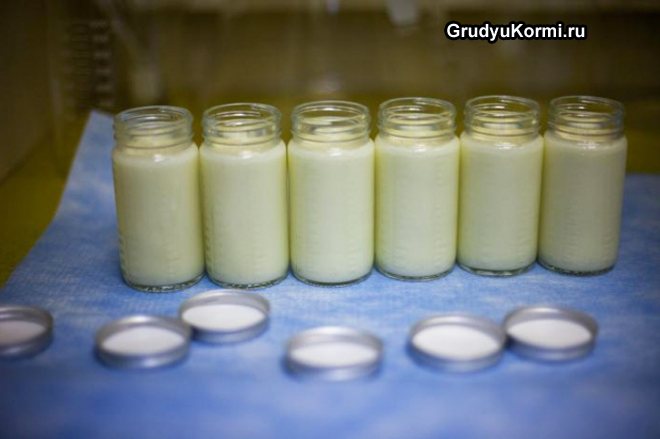
Breast milk is the best food for a baby. And for a newborn, this is the only suitable food for up to six months. Even the most modern and expensive mixtures cannot completely replace a product so ideally thought out by nature. Therefore, before separating from your baby, it is best to express the milk and leave it with your family to feed it.
This is also a good option when the baby cannot suck on his own. And if a mother is embarrassed to breastfeed her baby on the street, you can take expressed milk with you, put it in a thermos and give it to the baby in any public place. This way, a woman with a baby becomes completely mobile and does not need to limit her walks to the nearest park in order to quickly return home for feeding. You can travel, go away for the whole day in the confidence that your child is provided with tasty and healthy mother’s milk.
If you create a “bank” of milk and choose a way to warm it up, then even in the most emergency situation, the mother will be able to leave, leaving the child without any problems.
Feeding scheme and rules
Feeding with expressed milk from a bottle is carried out according to the same schedule as in the case of putting the baby to the breast. Pediatricians advise feeding newborns on demand. On average, babies need food every 2-3 hours.

It is important to follow the rules for bottle feeding your baby:
- the container into which the liquid is poured and the nipple must be clean;
- Milk should be offered to the baby fresh and of high quality. Do not give a product that has been stored in inappropriate conditions.
Experts recommend following the following bottle feeding algorithm:
- warm breast milk. The optimal liquid temperature is +34-36 degrees;
- take the baby in your arms and give him a reclining position;
- Offer your baby a bottle with a nipple. The baby should be fed at intervals of 2-3 seconds;
- hold the baby upright for about 3-5 minutes. This is necessary so that the air swallowed during feeding comes out and bloating does not occur.







